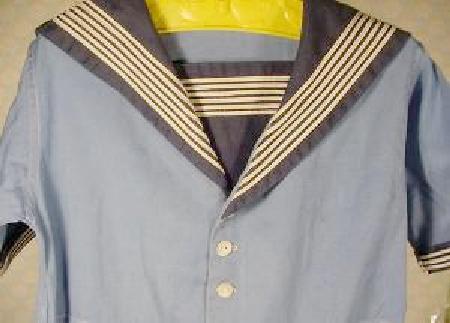
Figure 1.--This vintage sailor suit was probably worn in the 1930s by an American boy. Note the short sleeves and the multiple stripe detailing. |

|
Sailor suits were still commonly worn by boys in the early 1920s. Kneepants were still common, but by the mid-1920s were rarely seen. Boys pants styles shifted to knickers. Some boys still wore their sailor suits with long stockings in 1920, but by the middle of the decade boys were mostly wearing kneesocks. As sailor suits began to be worn increasinly by smaller boys in the 1930s, the came to be worn primarily with short pants rather than knickers. As a result, blue wool suits became less commonly worn and white sailor suits became much more common. Sailor suits were less commonly worn to school, except by the youngest boys. This was in contrast to Continental Europe, but not England, where boys up to 12 or in some cases even younger teenagers wore sailor suits--even short pants sailor suits.
We have compiled some data on sailor suits for the inter-war and World War II years. American boys in the 1920s still commonly wore sailor suits. The fashion was not as cmmom as during the period before World War I (1914-18), but it continued to be a popular fashion for younger boys. Sailor suits now were increasingly worn for play, but some boys still had dressy suits. The dressy suits seemed more popular for summer than winter wear. We have little information about sailor suits in the U.S., but note that they cmtinued to be adverized in mail order catalogs. Sailor suits were still worn in the United States during the 1930s. They were, however, decling in popularity. Middy blouses were still commonly worn by girls, but were not nearly as common as they were in the 1920s when they were one of the most popular styles for high school girls. We have limited information on sailor suits during this period. They were still worn, but less commonly than the 1930s. Most boys wearing sailor suits were pre-school boys or boys in their first few years of primary school. Presumably World War II helped to make sailor suits popular for boys.
We still see sailor tunics in the earky 1920s after World War I, but quickly went out of fashion. As far as we call tell, the fanciful sailor suit styles that were still relatively common in the early 20th century were no longer commonly seen by the 1920s. The sailor suits that we note in the inter-war years are relatively accurate reproductions of american naval uniforms. Most were blue and white as worn by sailors, but we also note some other colors like grey which were worn as playsuits. We note sailor suits being wirn as dressy outfits in Europe. This seems to have been less common in America.
The principal sailor suit garments in the inter-War years were the middy blouses and pants. We see some caps--mosdtly swabie type caps. Some of the bloyuses were traditioal blouses styled like naval uniform. More common were blouses that were styled for younger boys. Generally these sailor suits were made for boys only up to 10 years of age and more commonly anout 8-year old. We notice button-on styling and short sleeves. We notice a lot of self-belts. Even these blouses generally used stripes and the "V" front and were made to look somewhat like actual naval uniforms. Sailor suits during the period were made with short, knicker, and long pants. The long pants suits seem to have been especially popular. Some were done as bell bottoms. We see many short pants outfits as well. We see some knicker outfits, but not as many and mostly in the 1920s.
Sailor suits in America continued to be popular in the inter-War era, especially the 1920s. The sailor suit continued to be a very flexible garment. Younger children might wear sailor suits both for play or for dressing up. We see period catalogs offering quite a range of play suits one as sailor suits. They were often called wash suits. Younger boys might also wear these sailor suits to school. Sailor suits continued to be a style used to dress children in identical outfits. We see quite a few portraits and snapshots in the photographic record of the children in families dressed in sailor suits. This was especially the case of the 1920s, but we also see it in the 1930s. The sailor suits involved were normally traditionlly styled suits. We see more examples of the children wearing the lightcolord summer suits than the dark winter suits. Here the size of the family and the age and gender of the children were all factors.
Sailor Suit Country Related Pages:
[Return to theMain U.S. sailor suit chronology page]
[Austrian]
[Belgian]
[Danish]
[Dutch]
[English]
[French]
[German]
[Italian]
[Polish]
[Swiss]
[Ulster]
Other Related Pages:
[Sailor suits]
[Kilts]
[Smocks]
[Pinafores]
[Sailor Hats]
[Blouses]
[Ring Bearers]
[Long hair]
[Ringlet curls]
[Hair bows]
[Bangs]
[Collars]
[Bows]
Navigate the Boys' Historical Clothing Web Site:
[Return to clothing styles]
[Introduction]
[Activities]
[Biographies]
[Chronology]
[Countries]
[Bibliographies]
[Contributions]
[FAQs]
[Glossaries]
[Images]
[Links]
[Registration]
[Tools]
[Boys' Clothing Home]
